A couple of weeks ago I took a ‘cruise’ down the Thames from Tower Bridge to Greenwhich, on the way I noticed and had pointed out many interesting things and places along the river.
Saturday I decided to go explore some of those on the North bank of the Thames on foot [1]. The first part of my journey took me from Fenchurch Street to Wapping where I stopped for a beer and lunch.
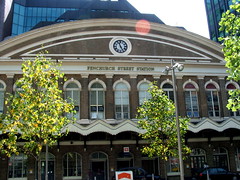 First port of call was Fenchurch Street station. Designed by George Berkeley, an engineer with the LTS and built in 1853-54 to serve the central London extention of the Blackwall railway as well as the London Tilbury Southend (LTS) line. The grey brick building has retained it’s Victorian charm over the years. It is however, rather less well known and used than some other mainline stations in London.
First port of call was Fenchurch Street station. Designed by George Berkeley, an engineer with the LTS and built in 1853-54 to serve the central London extention of the Blackwall railway as well as the London Tilbury Southend (LTS) line. The grey brick building has retained it’s Victorian charm over the years. It is however, rather less well known and used than some other mainline stations in London.
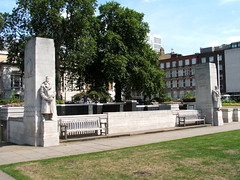 Heading away from the station towards the River and the Tower, the next interesting area is Trinity Square Gardens. This small public garden contains the site of the scaffold used for many executions on Tower Hill as well as the memorial to drowned and loster Fishermen and Sailors of the Merchant Navy (shown in the photo).
Heading away from the station towards the River and the Tower, the next interesting area is Trinity Square Gardens. This small public garden contains the site of the scaffold used for many executions on Tower Hill as well as the memorial to drowned and loster Fishermen and Sailors of the Merchant Navy (shown in the photo).
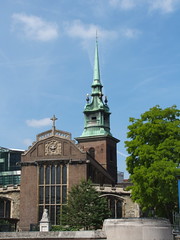 Turning 180 degrees from the monument in the gardens brings the impressive green copper spire of All Hallows by the Tower into view.
Turning 180 degrees from the monument in the gardens brings the impressive green copper spire of All Hallows by the Tower into view.
This is the oldest church in the City of London, the original church on this site having been founded in 675 by the Saxon Barking Abbey (the remains of which can be seen further downstream in Barking).
Being so close to both the Tower and the Tower Hill execution area, the church has dealt with many beheading victims including Thomas More and John Fisher. On more upbeat note, the church was the venue for the wedding in 1797 of John Quincy Adams later the 6th president of the USA (1825-1829).
The church has survived the great fire of London in 1666, which started a few hundred yards away in Pudding Lane. However was almost destroyed by a bomb in 1940, only the tower and a wall remained standing. The late Queen Mother laid a new foundation stone in 1948
and the church was re-dedicated in 1957.
From here we move into the estate of the Tower of London, much has been written about the tower proper, so I decided to locate a different building on the site to photograph and research. The Wharfinger’s Cottage down on the tower wharf by the the river cruise jetty was my target.
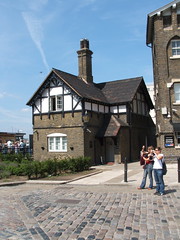 Wharfinger was an old term used to describe the supervisor of a river wharf.
Wharfinger was an old term used to describe the supervisor of a river wharf.
The building shown in the photo dates from the late 19th century, but is built on top of foundations dating back at least as far as the 1680s. The wharf in front of the tower used to be busy with goods, weapons and men arriving at and leaving from the Tower. The Wharfinger was responsible for the orderly running of the wharf and for prevention of thefts of goods. He lived on site with his family in the purpose built cottage.
The wharf is no longer used and so the the building is now used by the Tower administration.
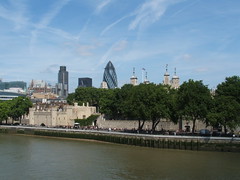
A final image to leave you with from this part of the journey is of The Tower of London and surroundings taken from ~130 ft up, on the west walkway at the top of Tower Bridge.
The Tower of London, showing Traitor’s Gate to the left of the photo and the four towers of the White Tower appearing above the trees.
delights of the boroughs on the South bank. His walk starts here

Nicely done…and some great pics, as usual ;o)